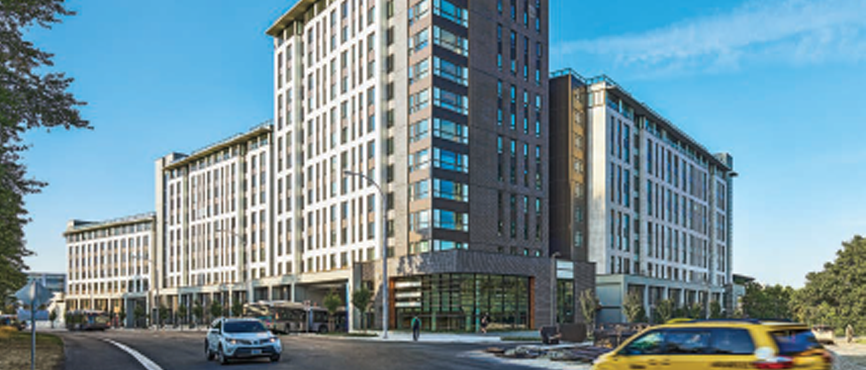The new Exchange Residence at Gage South & UBC Bus Exchange featured in August issue of Award

Resulting from a partnership between the University of British Columbia (UBC) and TransLink, the new Exchange Residence at Gage South & UBC Bus Exchange demonstrates how one site can comfortably serve a full range of purposes.
“The original project was to expand the bus exchange in its old location. When we heard the University was planning a new student residence and learned about the site, we realized there was an opportunity to integrate the bus exchange and student residence together in a centralized location,” explains Martin Nielsen of architecture and design firm Dialog. “After many concept iterations, the final outcome was to keep the bus loop at-grade and build the student residences above.”
Located just steps from UBC Aquatic Centre, UBC Student Recreation Centre, UBC Life Building, and many other key campus sites and amenities, UBC Bus Exchange is the second busiest stop on the TransLink network, servicing upwards of 50,000 person trips per day.
Above the bus loop, the new four-tower Exchange Residence, clad in brick veneer, curtain and window wall, and painted concrete, welcomes upper-year students home to a building designed to support a well-rounded university experience.
Inside, the building’s warm and welcoming interior design utilizes vibrant colours that support wayfinding and was inspired by the natural UBC shore-line, where ocean meets land.
The new residence provides approximately 650 beds through a diversity of unit types, including one- to four-bedroom suites, as well as nano suites, which offer independent living all within 140 square feet and are the first of their kind on the UBC campus.
“We feel that students are spending less time in their rooms and more time out socializing. The design reflects this by focusing on the social spaces available to the students,” says Sara Remocker of Dialog. “We wanted to create great public spaces that support and facilitate student life.”
The building offers a fitness centre, several multi-purpose rooms, a lounge and a vibrant lobby, all designed to encourage social interaction in the context of the active surrounding public realm.
“Exchange Residence promotes social sustainability through a multitude of activities – from studying and socializing in the lounges or games room, to unwinding on the outdoor recreational podium or fitness room,” explains UBC’s Andrew Parr.
With two collegia, Exchange Residence exudes the building’s design philosophy, offering spaces for relaxing, socializing, studying, and heating food. “Collegia are places where first-year commuter students are able to connect to a small community of peers, spend time between classes, study, relax, cook a meal, or maybe even take a nap,” explains Parr.
For those who crave a bit of solitude, the site is able to accommodate, notes Nielsen: “There are many places on the site where one can find sanctuary away from a crowd or some space to enjoy people watching on a quiet day.” Among such areas is the outdoor podium, which offers a quiet, rejuvenating space with native and adaptive plant species, or the house lounge with intimate booth seating and soft lounge chairs.
To encourage more sustainable modes of transportation, in addition to its focus around the UBC Bus Exchange, there are three bike rooms in the building, as well as bike hooks in many of the residential units.
The building achieves LEED Gold with the help of a high-performance building envelope for energy saving, low-flow plumbing fixtures, LED mercury-free lighting throughout, and water-efficient landscaping. “Windows are synced with the baseboard heating controls in residents’ bedrooms – if the window is open, the heat will shut off,” adds Parr, noting that significant energy savings are also achieved by omitting air conditioning.
Anthony El-Araj of Glotman Simpson Consulting Engineers says that the building’s primary structural system features conventional cast-in-place flat slabs, columns, shearwalls around the elevator and stairs, transfer slabs over the bus loop, and a conventional foundation system. However, it’s the building’s seismic aspects that are worthy of note: “The tower geometries are unique to the local market – they are not single point towers like most local buildings. They are rectilinear with separated elevator banks and stairs,” he explains.
“The four towers are linked, forming a L shape along the north and east faces of the project. This geometry poses seismic challenges as the towers needed to be designed to behave as one structure during seismic shaking,” he continues. “The diaphragm slabs that connect each tower required special attention, so as not to yield and fail during a seismic event.”
As Exchange Residence and UBC Bus Exchange gets ready to welcome its first tenants in the new school year, it stands as an example of UBC and TransLink’s commitment to invest and deliver infrastructure that grows and supports a strong community on campus and into the future.
“UBC is pleased with the successful design solution that has allowed us to effectively utilize limited campus land to address two fundamental needs for the University community,” concludes John Metras of UBC. “We appreciate the partnership and support from TransLink in undertaking this unique project.”
This article is by Laura Walker and originally published in the August issue of Award.
To view the August issue of Award magazine, click here.
For project information, click here.